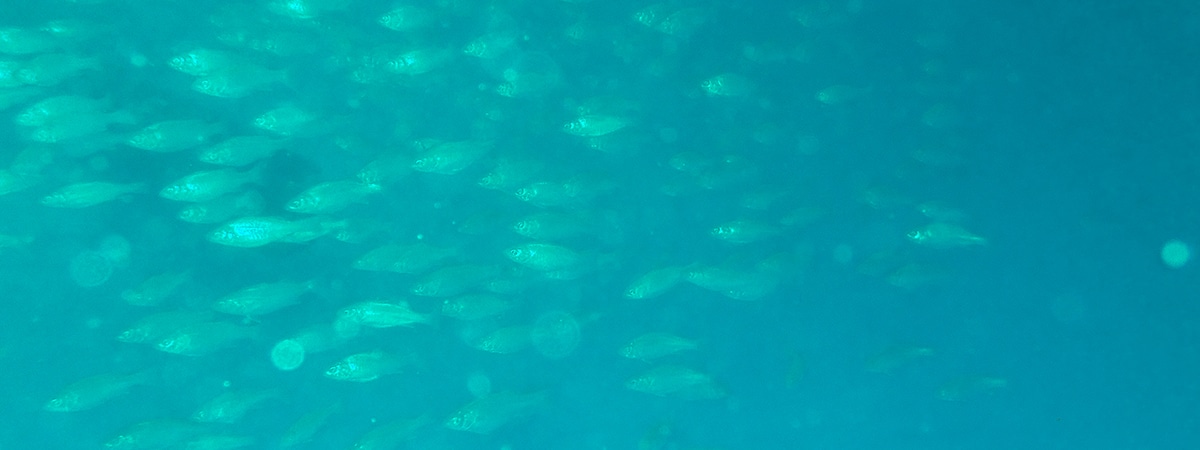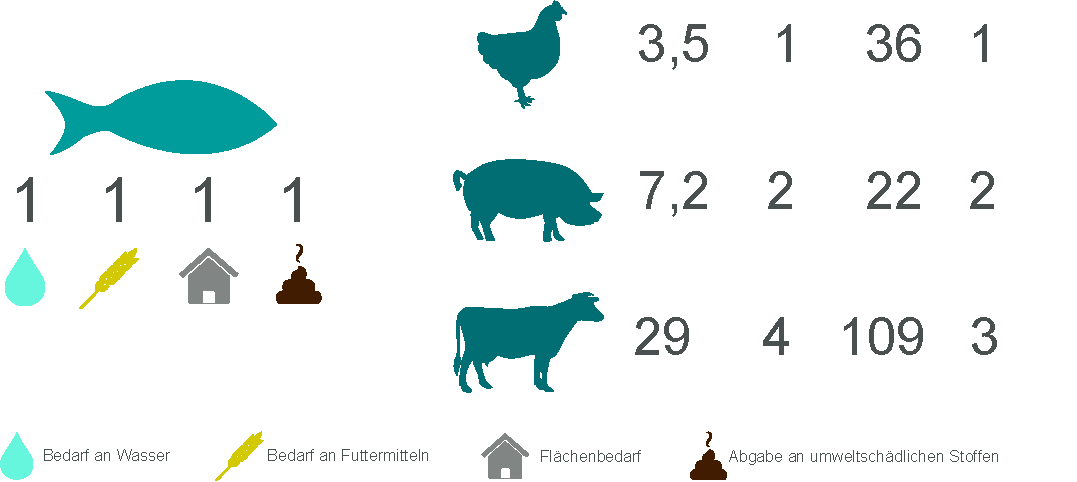Resource consumption of animal breeding in comparison

As consumers and buyers, we are used to full refrigerated counters in Germany: whether beef, pork, poultry or fish, everything is always available in rough quantities. If we now consider how many supermarkets there are in our area, this consumer offer quickly adds up. What consumers often fail to consider, however, is that enormous resources are required for the growth of the animals. Logically, the larger the animal, the more water and feed are needed. But animals – just like humans – do not fully utilize everything they eat. Due to the increasing scarcity of water and the rising protein requirements of our rapidly growing world population (according to forecasts, nine billion people will live on the earth in 2050), the question arises as to which animal is most efficient in the use of natural resources in terms of meeting our protein requirements?
To answer these questions, we make a comparison between fish, poultry, pork and beef. We investigate feed conversion, water consumption, land use, and the pollution of groundwater and air during the production of one kilogram of protein. We use the consumption data of sea fish from aquaculture as a basis and refer to the data of other species.

Although fish live in a large water body, it has been shown that the freshwater consumption in fish farming is significantly lower than in other animal husbandries. The difference comes from the fact that this balance includes not only the surrounding or drinking water but also the water consumption for feed production. The more feed an animal requires, the greater the water consumption.
If you look at the feed requirement, fish and poultry are on the same level. Pigs need about twice as much feed as fish and cattle even four times as much to gain body weight. This is because fish are warm animals. Their body temperature always corresponds to the ambient temperature and they do not need the food to produce body heat. All the energy in the food is therefore converted into biomass. Chickens, pigs and cattle, on the other hand, need part of the feed to maintain their body temperature of approximately 39°C. Therefore, they have to take in considerably more feed.
In terms of space requirements for the production, theoretically more fish than any other animal protein source can be produced in the same space. On the one hand, this is due to the fact that fish are swarm animals and are generally comfortable even with high stocking densities. On the other hand, the area required for feed production must also be included in the balance. About 80 % of the world’s agricultural land is used for fodder production and pastureland for livestock breeding. This means that land consumption in livestock farming is enormous and many times greater than in fish farming.
Other resources that are influenced by food production are groundwater and air. Groundwater is polluted when too many animals are kept in a too small space and then more nutrients are released into the soil through the excrements of the animals, i.e. liquid manure, which is spread out on the field, than the soil can tolerate in the natural cycle. Due to the increased nutrient content, especially nitrogen is released from the soil during rainfall and enters the groundwater. This process is also known as „eutrophication“. The air is also polluted by livestock farming. Besides CO₂, the methane produced by ruminants (cattle) during digestion is mainly responsible for the emission of climate-damaging gases. In addition, ammonia contributes to the impairment of air quality as a result of liquid manure fertilization.
In view of these figures, we can therefore clearly answer the question of the most efficient animal food: fish has the least impact on the environment during production compared to all other animal protein sources. But we should not rest on our laurels, because fish farming also has environmentally harmful and environmentally friendly systems (see blog post). Our aim is to make fish farming as resource-saving and animal-friendly as possible. The SEAWATER Cube as a closed recirculating system fulfils this claim. With the help of biological and mechanical filter stages, more than 99% of the water in the plant is recycled, only a small proportion of the residual substances is still discharged as sludge. In addition, the feeding of the animals is optimized, and the control system ensures that only as much is fed as the animals can take in. We have also determined an optimal stocking density for our fish species, at which the animals do not feel stress and do not get sick, and at which production is as efficient as possible. However, at 65 kg/m³, this is significantly below the tolerable stocking density of 100 kg/m³ specified in the literature.
Ultimately, every consumer should ask himself the question of how much meat he really wants to include in his nutrition and how the relationship between the various animal species can be changed with respect for the environment. If we were to change our eating habits and cover a larger proportion of our protein requirements with fish in the future, the free agricultural land could be used to grow rice or potatoes, for example. This would save valuable freshwater and at the same time more people could be fed by plants.
References:
— Ernährungs- und Landwirtschaftsorganisation der Vereinten Nationen (FAO) Berichte von 2006, 2010 und 2012
— Thünen Institut für Marktanalyse, Gerd Hubold und Rainer Klepper, „Die Bedeutung von Fischerei und Aquakultur für die globale Ernährungssicherung“, Thünen Working Paper 3, Braunschweig, 2013
— https://www.zeit.de/wirtschaft/2013–08/fleisch-konsum-ressourcen/, 29.09.2018
— https://www.peta.de/weltwassertag, 07.03.2019
— https://mobil.wwf.de/fileadmin/fm-wwf/Publikationen-PDF/wwf_studie_wasserfussabdruck.pdf, 07.03.2019
— https://www.welt.de/wissenschaft/article6012574/Ein-Kilo-Rindfleisch-kostet-15–000-Liter-Wasser.html, 07.03.2019
— https://www.umweltbundesamt.de/daten/land-forstwirtschaft/beitrag-der-landwirtschaft-zu-den-treibhausgas#textpart‑1, 07.03.2019